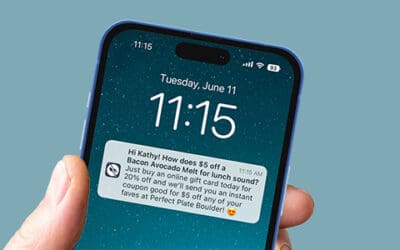
The Competitive Advantages of Shifting from Personalization to Hyper-Personalization
To date, personalization has only scratched the surface — it’s been fundamental at best. While it has improved customer engagement and satisfaction, its limitations have become apparent as consumer expectations and technological capabilities continue to evolve.
Have you ever received personalization in the past that’s not really personalized? Getting an email with your name on it or remembering your birthday? Well, neither of those is actual personalization. They’re just data points pulled into an email or some other type of communication. I don’t know about you, but that doesn’t feel very personalized to me and my interests. Many users now demand a more individualized and seamless experience that goes beyond mere segmentation based on surface-level data. This calls for the implementation of a hyper-personalization strategy.
The Evolution to Hyper-Personalization
While traditional personalization offers a tailored experience, it only relies on static data sets. Hyper-personalization on the other hand takes personalization to a whole new level. It leverages advanced technologies: real-time data, machine learning (ML) and AI. This approach involves analyzing a vast amount of data, including online behavior, location, and even sentiment analysis. ML algorithms play a crucial role in processing these data in real-time, enabling businesses to send highly contextualized communications to specific customers at the right place and time, and through the right channel.
One of the key differentiators of hyper-personalization is the ability to create a unique experience for each customer, treating them as an individual rather than part of a segment. Even without ever mentioning the customer’s name, they will still recognize that a brand understands who they are and anticipate their needs based on implicit and explicit behaviors.
For instance, several of LighthousePE ‘s clients take advantage of competitor visit behaviors. Basically, if a customer breaks a competitor’s geofence, that will prompt the AI to deliver a push notification with a specific-hyper-personalized offer. The behavioral data collected also provides clients with insights into the customers’ preferences and behavioral patterns. These insights will allow for additional automated and hyper-personalized messaging based on predictive behaviors and location.
AI hyper-personalization gets to the Holy Grail of marketing. It allows for one-to-one communication at scale. Unlike traditional personalization, the AI can synthesize customer behavior with real-time location data then automatically creates hyper-personalized messages and experiences in real time.
Key Differences and Advantages of Hyper-Personalization
Real-Time Responsiveness: Traditional personalization relies on historical data, which might not capture the most recent changes in user behavior. Hyper-personalization, on the other hand, adapts in real-time, ensuring that the user experience is always current and relevant.
Individualization vs. Segmentation: While traditional personalization segments users into groups based on shared characteristics, hyper-personalization tailor’s experiences at the individual level. This level of granularity enables businesses to connect with users on a more personal and meaningful level.
Predictive Analytics: Hyper-personalization often incorporates predictive analytics, allowing businesses to anticipate user needs and preferences. This proactive approach goes beyond reacting to past behavior, providing a forward-looking strategy for engaging users.
Multichannel Integration: Hyper-personalization extends across various channels seamlessly. Whether a user is interacting with a website, mobile app, or social media, the experience remains consistent and personalized, fostering a unified brand experience.
Enhanced Customer Loyalty: By delivering highly personalized experiences, businesses can build stronger emotional connections with their audience. This emotional resonance leads to increased customer loyalty, as users feel truly understood and valued.
Key Takeaways and Actionable Insights
The emerging trend of hyper-personalization underscores several key insights. First, the importance of collecting and analyzing customer behavioral data cannot be overstated. This data is the foundation for creating personalized experiences that truly resonate with your customers. Second, businesses must embrace real-time and dynamic content delivery. Customers’ motivations and behaviors change rapidly, and your marketing efforts need to keep pace.
Lastly, it’s essential to create hyper-personalized experiences across multiple touchpoints. From email marketing to social media to your mobile app, every interaction with your customer should feel personal to them. However, while implementing hyper-personalization strategies, businesses should prioritize privacy and data security. Ensure you have the necessary consent and permissions from customers to use their data for hyper-personalized marketing.
Hyper-personalization is more than just a buzzword; it’s a powerful tool that can propel your business to new heights. By understanding your customers on a deeper level and delivering experiences to them that feel extremely relevant, you’ll not only drive engagement and conversions but also foster long-term loyalty.
If you would like to learn more, contact me at [email protected] or book a time to speak here.
You may also be interested in
How the Right AI Can Expand the Casino Player Experience
Most casinos aren’t fully embracing AI, and, in turn, they’re missing opportunities to take care of their existing players and outpace their competition. Unrealized potential awaits—from enjoying the benefits of a true attribution channel to delighting players with...
How AI Automation Will Drive Mobile App Marketing Success
As much as we may hate to admit it, our smartphones and the apps on them have become an essential part of our lives. We use them for everything. They help us order food, shop, bank, and be entertained. Consider this fact: Last year, the number of holiday purchases...
Drive Business Growth Through the Power of Push Notifications
Have you ever received a push notification on your phone that grabbed your attention? Perhaps it was a discount code from your favorite store or an alert about an event you were keen on attending. The key factor that made it stand out among the clutter on your lock...
Overcommunicating with Your Customers Is Worse than Not Communicating at All
It recently hit me that I’ve been getting tons of emails and push notifications from brands. I started monitoring it. When I realized how bad some of the communication was, I got frustrated and started unsubscribing. And that’s what brought me here: overcommunicating...






